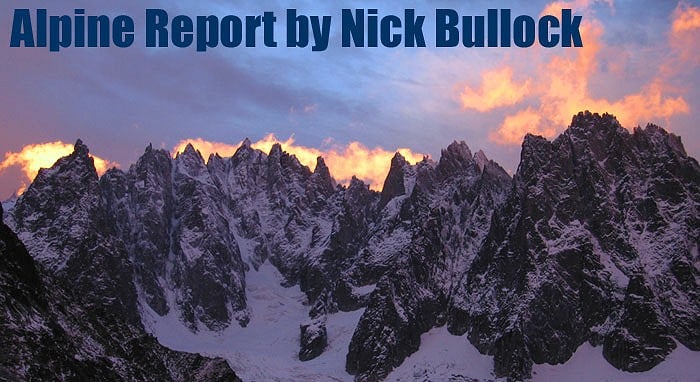
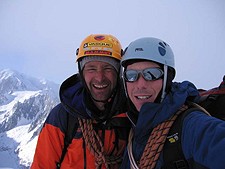
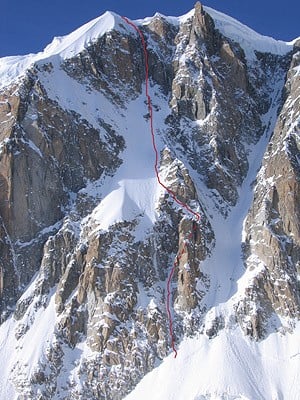
December was when the crowds started to queu at the foot of the Pettit Jorasses with the discovery that Omega (WI 6 5.10 A3, 700m, Gabarrou-Latorre, 1994 ) was in 'easy' condition. Unlike the long awaited second ascent which took 10 years, IV 5+R M6 A1+, 9th-10th Dec 2004. (Batoux/Peyronnard) and the closely followed first free ascent, (Bullock/McAleese, Scottish VIII/8) this year a continuous streak of ice ran the length. Kenton Cool made an early repeat with Neil McNab stating the climbing no harder than WI 5+. After numerous ascents through January and February, Andy Benson, brother of Pete mentioned above, described the climb as becoming a tad tricky with large gaps appearing in the thin sheen.
To the right of Omega , the very ephemeral L'Oeil au Beurre Noir (IV/5+, 600m, Bernard-Cayrol, 1993) on the far right side of the Petites Jorasses west face is also in a nice fat state, i.e. Scottish VI/6 and lots of it, and, like Omega, has probably received more ascents this winter than before. To the right again the NW Gully of the Frébouze (III/4+, Charlet/Ghilini/Peyroulet, 1979.) has seen many ascents, a fine climb following thickly iced corners at a reasonable angle and with regular in-situ abseil points, low commitment.
High Pressure dominated through mid December. Little snow combined with plastic ice brought the Vallée Blanche Basin into great condition. Point Lachenal, triangle du Tacul and The Mont Blanc du Tacul were especially good. Skiing is usually the best way for approaches in winter, but with the minimal snow, booting in was no problem and at times, an advantage before the Vallée Blanche had enough snow to make skiing down a possibility. Many teams have climbed the Gouault/Haston test piece climbs from the 90s, Scotch on the Rocks (IV 7) and Pinocchio, (IV 6+). The latter proved to be a lot easier than the former under thick ice in the lower section with blobs of plastic and some dry mixed higher up. To try and make a comparison with a Scottish climb is very difficult as Pinocchio, a sustained 10 pitch climb, (loads of Scottish technical 6 and 7) would be very hard to find in the U.K. Think of the crux of Point 5 followed by one of Stob Corrie Nan Lochan's test piece mixed climbs topped with a bit of Eagle Ridge on Lochnagar and you'll get the idea.
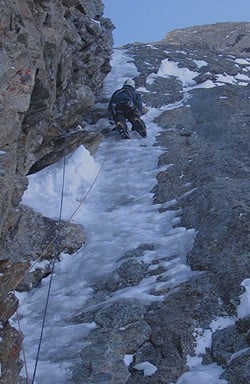
Seeing few ascents, but of similar length and quality are the lines to the right of Pinocchio. Jon Bracey and Twid Turner made possibly the first British ascent of Vol de Nuit, (Jasper/Klindt 1997 IV/8-). Jonny Baird and I repeated Vol de Nuit a few weeks later. I found the crux similar in grade to Scotch, but a very different climbing style is needed to get into and out of the offwidth on the crux pitch. Thin seams, shallow hooks, chest heaving exposure...
The whole outing was of a Scottish grade of VII/8. Take any of the Richards/Cartwright lines in Coirre na Ciste on the Ben (Darth Vader, Cornucopia etc) times by three and you have it. Although most activists here in the Alps use the M grade, I feel Scottish grading is more comparable, as you will not find any bolts on these climbs and hopefully never will.
Just to the right again is the Parkin/Taylor line, Slave to the Rhythm. Possibly the least climbed of the four hard climbs in this area. Kenton Cool and I made what was, (we think) the second full ascent of the climb. The climbing on Slave was more difficult than nearby Pinocchio, but less so than Scotch on the Rocks. The crux being the entry pitch: steep, thin ice leading to a spooky booming flake and an offwidth to finish. However, three other pitches were almost as difficult. High up, the angle eases and two rope lengths of snow bashing lead to the final pitch. Pulling past the overhanging chock on the final pitch involved good torques but with crampons smeared on the right wall it all felt very insecure. It was also loose. A large rock fell into my lap, the spindrift whipped by the wind blinded, the night closed in. Screaming, screaming...I had to let the rock fall, fortunately it missed Kenton who was wondering what I was messing at. A night-time ski back to the Midi telepherique station in gale force winds, having to use both axes for placements while crawling up the final section of the path was probably the hardest part of the day.
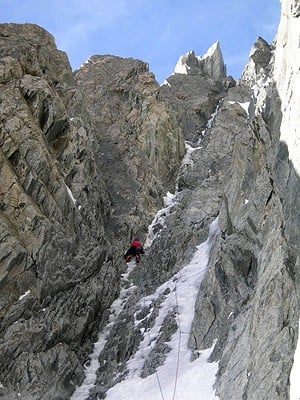
For most of the winter the other climbs on the East face of the Tacul including The Super Couloir (IV 5+, M6 Boivin/Gabarrou 1975), The Lafaille Gully, (J-C Lafaille 1985, II 4), Valéria Gully, (Grassi/Rudatis IV/4+ 1987), Gabarrou/Albinoni, III/4+, 1974, Modica/Noury, III/5+ 1979, have all been in exceptional condition and in the periods of settled weather, climbed on a daily basis.
To the right of the East face of the Tacul is the small summit of Point Lachenal,(3613m) named after the great French mountaineer, Louis Lachenal, the first man (with Maurice Herzog) to climb an 8000-meter peak (Annapurna) and who was killed in 1953 not far below the base of the peak when he skied into a crevasse. The formation is best known for its short and highly popular, quality rock routes on the east and southeast faces, such as the classic Contamine (250m, Contamine-Labrunie-Wohlschlag, 1959), Harold and Maud (250m, Afanassieff-Escande, 1979) and Le Bon Filon (200m, Long-Vogler, 1988).
After arriving in Chamonix for the winter on the 15th of December 2006, I teamed up with Jon Bracey and on the 16th climbed M6 Solar (Batoux, Cruaud, Robert III 5+, 1998) a beautiful little mixed line on the right of Point Lachenal. On the 17th Bracey and I passed under the whole of point Lachenal to climb Scotch on the Rocks and spotted an obvious unclimbed icy corner. The following day we returned to climb the new route Tentation III/6. Nine pitches of sustained climbing ranging from Scottish 5 to 7. Neil Brodie and Jean-Francois Mercier climbed the second ascent of Tentation from the first Telepherique a few days later. Armed only with the picture published on UKC and my poor description, they joined several of the pitches together, and climbed a more direct last pitch getting back to the valley in the afternoon.
Neil says “We did a direct last pitch which was probably Scottish 8 if the rest was 7. I know f**k all about Scottish grades! (Brodie is of Scottish/Irish origin and a French mountain guide who has hardly climbed in Britain) There was no hoar frost to brush off which I imagine makes things an awful lot harder in Scotland.”
In early January Andy Houseman and I, seeking out the quieter areas of the range walked into the Col de Forche Bivouac hut, studied options and decided to attempt Gian Carlo Grassi's Overcouloir (TD+, IV/5, 700m, Grassi-Margaira-Siri, 1986) on the southeast face of Mont Maudit (4465m: though the face tops out at Pointe 4361m—the Southwest Shoulder). The steep ice fall through the lower rock band wasn't properly formed, so taking a direct three-pitch Peruvian style variation at the top of the couloir we reached the snow slope half way up the face. From the top of the snow field Country Couloir was climbed. Vertical and bulging, hard but perfect ice poured, riding the cleft sandwiched between steep walls for two 60 metre pitches of WI 5 with a sack was testing.
“Shit, my calves are screaming, this is no place to get back into steep ice” Houseman screamed passing the 4000-metre mark. A third pitch at an easier angle was climbed quickly. The summit seracs overhung the line and the sun shone. A fourth pitch of snow bashing put us on the summit of point 4361 at approximately 1pm. The walk off from Maudit is by no means straight forward. We missed the last bin by half an hour. The Midi Lifties were getting to know me quite well... “Ah, it is that English man who is not quick enough.”
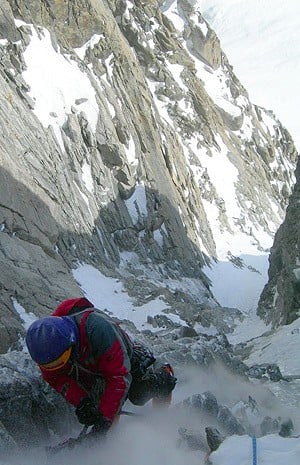
A dump of snow and baltic temperatures stopped things for a while in late January until Mr Dark Horse himself Neil Brodie called our house and persuaded Kenton Cool out to play. (For once I'm glad Kenton took that call.) In very cold temperatures, gales and deep snow, the pair climbed Brain Death and Bad Craziness (Dale-Thornhill, V/4, M, A1, 550m.) on the Aig du Plan. Neil describes below,
“Brain Dead was relatively straightforward apart from the last 2 pitches, but having discussed it with a friend, it sounds like we didn't take the best exit (we didn't have a description with us). We took the left-hand line up steep, loose rock and it all felt quite hard, but that might just be because there was a lot of snow to clear and the temperatures were baltic. The right-hand line probably gives better and maybe easier climbing. Great route though - should be a classic.”
The A1 section was also climbed free, and by Kenton's state as he crashed into the apartment at 11pm, they both had a good time.
The Grandes Jorasses north face is exceptionally dry this winter, the Shroud is grey and The Colton/McIntyre has not formed. Being so dry a winter ascent of The Walker Spur, (Cassin/Esposito/Tizoni 1938, III/5c/6a), is the obvious choice for those wanting to climb one of the six classic north faces of the Alps. When things had settled down and warmed up, Marko Prezelj, Vince Anderson and Steve House ploughed a six hour trail from the Leschaux Hut to the base of the Walker and then spent 2 bivvies to go up and over.
At the same time Andy Houseman and I decided to have a look at the Sans Nom, in particularly the rarely climbed There Goes the Neighbourhood (V 6, 5c/A3 Twight/Backes 1993). The first two pitches of thin-overhanging ice went well but on finding the upper pitches dry, we traversed the whole of the median slope 40/60º. The summit ridge was gained by climbing the Cohen/Collister (V 5, 1000m 1976), and making a bivvy beneath the summit. The following day the Verte was traversed and the Whimper Couloir abseiled. Unfortunately the last train was missed by half an hour.
The railway workers leaning from the stations upstairs window glugged beer and ignored us looking-in-longing, but the red and brown, grey, white and blue glowing hues of a wonderful clear evening quenched my thirst. Andy and I stood at the rails of the Montenvers Train station preparing for the walk to the valley. The helicopter buzzing the west face of the Dru had been hovering for a long time now. Looking close, a small black dot could be seen beneath an overhang.
“Looks like Brodie's mate found a partner.”
Neil had told us of a phone call he had received a few days before.
“Neil, the weather is good, fancy climbing what was the Bonnatti Pillar.”
Brodie for once, bottled it, declining the offer.
Martial Dumas had found a willing partner in Jean-Yves Fredericksen and started their adventure from the Grands Montets on January 29 with approximately 100kg of equipment including a portaledge and food for 10 days. Climbing in capsule style through temperatures that were relatively mild at the time (quoted as around -10 degrees C) the pair reached the top of the rock scar in six days. On the seventh, February 4, they continued up the old red granite to the summit Madonna. Reportedly breaking their hand drill early in the climb, the two were not convinced they could continue, but devious route finding and making the best of the considerable amount of loose rock on the face, they won through, returning the following day down their route of ascent to the valley.
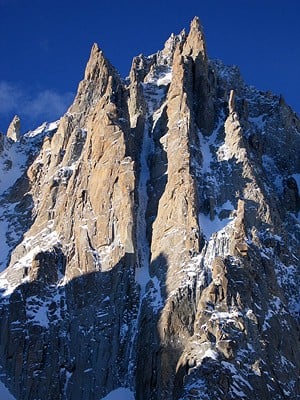
The ultra classic Rebuffat/Terray (August 1944) or as it is more commonly referred to by Brits, the Rouse/Carrington (1st winter ascent 1975, V/5, 550m) on the NE face of the Pélerins has been climbed but it is not in the normal great condition you would expect at this time of year. A stunning line, 2-4 hours depending on snow conditions and whether you are on foot or skis from the Plan telepherique. Well equipped for abseil and saving the crux for the final pitch (if well iced Scottish technical 6, if not well iced, 7, this is one of the best. Le Fil á Plomb (III/4+, 700m, Tavernier/Radigue) on the Rognon du Plan has been in condition all winter. Another brilliant climb with easy access and a telepherique at the top. Much of the climb is straightforward gully bashing, but the crux pitch is a steep slab of thin ice (70/80º, about Scottish 5 or 6 depending on the thickness of the ice.) To the right the north face of the Midi has also been in good condition. The Mallory/Porter Route (II AD+, 1000m, 1919). Eugster Direct (Hugonnot/Marjoux, IV/5, 1000m, 1964) and the NW Ridge (Livacic/Martinetti, 1100m, 1942) have all seen several ascents.
Finally, just before the weather broke I teamed up with Lakeland mixed climbing guru Steve Ashworth, to make a rare repeat of Fantasia per a Ghiacciatore (V, 5+, 6a, Gabarrou-Gourdin-Passino, 1989), in Cirque Maudit. Excellent sustained mixed climbing and thinly iced corners similar to the crux of Beyond Good and Evil are climbed direct. Many of the mixed sections were of a Scottish technical grade of 7, and the ice was sustained at Scottish 5-6. Spindrift whipped by the strong winds poured down the final two pitches that were hard and loose. After the brilliant climbing in the sun lower down it was a shock to suddenly be thrust back into winter. The descent of Filo di Arianna, the climb to the left (which has seen a lot of action and is fairly steady until the final steep corner crack) was scary to begin, (a 4mm loop of cord around a sharp flake and a free hanging abseil) but soon turned into a standard equipped descent. Unlike most of the climbs on the Tacul, every belay had to be constructed on the way up and in the upper section, the loose nature of the rock makes for a serious finish in a wild and reclusive corner of the range. Perhaps the most difficult part of the day for Ashworth was the long ski back to the Midi.
Disclaimer:
Conditions have been known to change in the mountains making all grades subjective. The Scottish grades I have given are meant to be a guide only. If you go and climb one of the above mentioned and find it different, easier or harder than I did, so be it. Welcome to the real world.
Thank you to Andy Houseman and Steve Ashworth for the photographs illustrating this report.
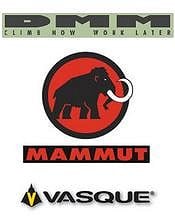
In Wales he made the first ascents of Cracking Up IX/9 and Travesty VIII/8 on Clogwyn Ddu. Snowdonia. On Ben Nevis he made the first ascent of Avenging Angel, VII/8 and in the Lakes he made the second ascent and first onsight of Snicker Snack on Great Gable (VIII/9).
He has made many fine ascents in the Huayhuash range and the Cordillera Blanca iof Peru, has attempted Shark's Fin and Changabang in India and climbed extensively in Pakistan and Nepal.
Nick is also a writer and you can read some of his work at UKClimbing.com. His essay Echoes, recalling his 15 years working in the Prison Service provoked many responses down the forums and has been read over 4,000 times. Read Echoes (click here)
Nick is sponsored by DMM (website), MAMMUT (website) and VASQUE (website).



Comments